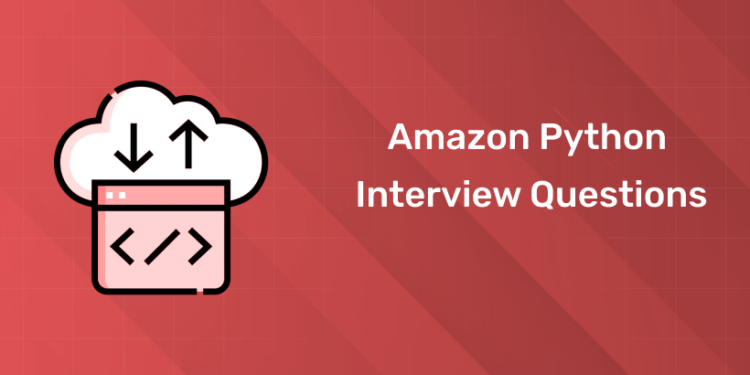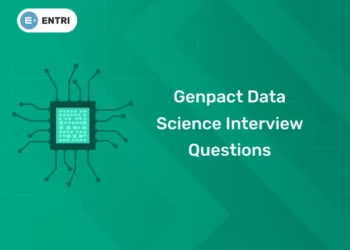Table of Contents
Preparing for an Amazon tech role? Python is often a key focus in their interviews. This guide provides essential Amazon Python interview questions, covering basics, advanced topics, and real-world problem-solving to help you ace the process.
Get hands-on with our python course – sign up for a free demo!
Introduction to Amazon
Amazon, the global leader in e-commerce, cloud computing, and artificial intelligence, is one of the most sought-after companies for tech professionals. Founded by Jeff Bezos in 1994, Amazon has transformed the retail industry and continues to dominate in areas like AWS (Amazon Web Services), Alexa, and entertainment through Prime Video.
As a tech-driven company, Amazon is renowned for its commitment to innovation, a fast-paced work culture, and problem-solving capabilities. This reputation makes it a dream destination for aspiring developers, software engineers, and data scientists.
Amazon conducts rigorous interviews to ensure that only the best candidates join their ranks. Python, being one of the most popular programming languages for its versatility and efficiency, is often a key focus during Amazon technical interviews.
Why Join Amazon?
1: Which of the following data types is immutable in Python?
Before diving into interview questions, let’s explore why Amazon attracts top talent worldwide:
1. Global Impact
- Amazon serves millions of customers across the globe and continues to expand its reach. By joining Amazon, you contribute to creating services and products that impact lives on a massive scale.
2. Innovation at Scale
- Amazon’s culture emphasizes thinking big, and employees are encouraged to experiment, innovate, and solve complex problems.
3. Competitive Compensation
- Amazon offers attractive salaries, stock options, and a comprehensive benefits package, making it one of the best-paying companies in the tech industry.
4. Learning Opportunities
- Working at Amazon means exposure to cutting-edge technologies, a chance to work with some of the brightest minds, and ample opportunities for professional growth.
5. Leadership Principles
- Amazon is driven by 16 leadership principles that foster customer obsession, ownership, and a bias for action. These principles create a dynamic and purpose-driven workplace.
6. Work-Life Balance and Inclusivity
- Amazon offers flexible work arrangements, supports diversity and inclusion, and provides a platform for employees to thrive personally and professionally.
Amazon Python Interview Preparation Tips
To excel in an Amazon Python interview, preparation is crucial. Follow these tips to improve your chances of success:
1. Understand Amazon’s Interview Process
Amazon’s interview process for tech roles generally includes:
- Online Assessment: Focuses on coding problems, logic, and algorithmic thinking.
- Phone Interview: Tests technical knowledge and problem-solving skills.
- On-Site/Virtual Interviews: Consists of 4–5 rounds with emphasis on system design, behavioral questions, and coding.
2. Brush Up on Python Basics
Python is known for its simplicity, but the interview will test your depth of knowledge. Cover these basics:
- Syntax and data types (strings, lists, dictionaries, tuples).
- Control structures (loops, conditionals).
- Object-oriented programming in Python.
3. Focus on Data Structures and Algorithms
Amazon interviewers value strong problem-solving abilities. Be proficient in:
- Arrays, strings, and hashmaps.
- Linked lists, stacks, and queues.
- Graphs and trees (traversals, BFS/DFS).
- Sorting algorithms (merge sort, quick sort).
4. Practice Coding on Platforms
Use platforms like LeetCode, HackerRank, and GeeksforGeeks to solve Python problems. Focus on medium to hard difficulty questions.
5. Learn Amazon Leadership Principles
Amazon values behavioral alignment with its leadership principles. Practice answering situational questions using the STAR method (Situation, Task, Action, Result).
6. Mock Interviews
Conduct mock interviews with peers or use professional platforms to simulate the actual interview experience.
7. Understand Python’s Libraries
Amazon projects often require knowledge of Python libraries. Familiarize yourself with:
- NumPy and pandas (data manipulation).
- Matplotlib and seaborn (data visualization).
- Flask or Django (web development).
8. Prepare for System Design
For experienced roles, be ready to discuss high-level system design and architecture. Learn concepts like database scaling, caching, and API development.
Top Amazon Python Interview Questions and Answers
Here’s a categorized breakdown of popular Python interview questions with explanations and sample answers.
1. Basic Python Questions
Q1. What is Python, and why is it popular?
Answer:
Python is a high-level, interpreted language known for its simplicity, readability, and versatility. It is widely used in web development, data science, AI, and automation. Its extensive library ecosystem and cross-platform compatibility make it highly popular.
Q2. What are Python’s key features?
Answer:
- Ease of Learning: Readable and beginner-friendly.
- Interpreted: Executes code directly without compilation.
- Dynamic Typing: Variable types are inferred at runtime.
- Extensive Libraries: Supports diverse applications, from web to AI.
- Community Support: Large and active community for resources.
Q3. Explain the difference between is and ==.
Answer:
is: Checks if two objects refer to the same memory location.==: Checks if the values of two objects are equal.
Example:
Q4. What are Python’s data types?
Answer:
- Numeric:
int,float,complex. - Sequence:
list,tuple,range,str. - Set Types:
set,frozenset. - Mapping Type:
dict. - Boolean:
bool.
Q5. What is Python’s Global Interpreter Lock (GIL)?
Answer:
GIL is a mutex in CPython that allows only one thread to execute Python bytecode at a time. This simplifies memory management but limits true parallelism in multithreading.
2. Python Data Structures
Q6. How do you reverse a string in Python?
Answer:
- List: Mutable, slower, allows insertion and deletion.
- Tuple: Immutable, faster, often used for fixed collections.
Q9. Write a Python function to remove duplicates from a list.
Q10. How do Python dictionaries work?
Answer:
Python dictionaries use a hash table internally. Keys are hashed to calculate an index for storing and retrieving values efficiently. Hash collisions are resolved using chaining.
3. Algorithms and Problem-Solving
Q11. Write a Python function to check if two strings are anagrams.
Q12. Solve: Find the maximum product of two integers in a list.
Q13. How do you find the intersection of two lists?
Q14. Implement binary search in Python.
Q15. Write a Python function to generate Fibonacci numbers.
4. Python Libraries
Q16. What is the difference between NumPy arrays and Python lists?
Answer:
- NumPy Arrays: Faster, supports vectorized operations, requires homogeneous data types.
- Python Lists: Slower, supports heterogeneous data types.
Q17. Write a code to plot a line graph using matplotlib.
Q18. How do you read a CSV file in pandas?
5. Advanced Topics
Q19. What is Python’s method resolution order (MRO)?
Answer:
MRO determines the order in which base classes are searched when executing a method. Use ClassName.mro() or __mro__.
Q20. How does Python manage multithreading with the GIL?
Answer:
The Global Interpreter Lock (GIL) allows only one thread to execute Python bytecode at a time. Use multiprocessing for parallelism.
6. Behavioral Questions
Q21. Describe a time you solved a difficult technical problem.
Answer: Use the STAR method (Situation, Task, Action, Result).
Q22. How have you demonstrated ownership in a past project?
Answer: Share a detailed example showcasing leadership and accountability.
Additional Questions
Q23. Write a Python function to merge two sorted lists.
Q24. Explain Python’s decorators and provide an example.
Answer:
A decorator in Python is a function that modifies the behavior of another function or method. Decorators are often used for logging, access control, caching, or input validation.
Example:
Q25. Write a program to find the longest palindrome in a string.
Q26. What are Python’s magic methods?
Answer:
Magic methods (also known as dunder methods) in Python are special methods that allow objects to implement or interact with built-in behaviors. They are denoted by double underscores before and after their names, like __init__ or __str__.
Common Magic Methods:
__init__(self, ...): Constructor, initializes a new object.__str__(self): Defines the string representation of an object.__repr__(self): Returns an official string representation of the object.__add__(self, other): Implements addition (+operator).__getitem__(self, key): Enables indexing likeobj[key].__len__(self): Returns the length usinglen(obj).
Example:
Q27. How do you serialize and deserialize objects in Python?
Answer:
Serialization is the process of converting an object into a format that can be stored or transmitted (e.g., JSON or binary). Deserialization is the reverse process.
Example using pickle:
Example using json:
Q28. What’s the difference between multithreading and multiprocessing?
Answer:
| Aspect | Multithreading | Multiprocessing |
|---|---|---|
| Definition | Multiple threads in the same process. | Multiple processes with separate memory. |
| Concurrency | Limited by GIL in CPython (single thread runs at a time). | True parallelism (independent processes). |
| Memory Sharing | Shares memory space among threads. | Each process has its own memory space. |
| Use Case | Suitable for I/O-bound tasks. | Suitable for CPU-bound tasks. |
| Library | threading module. |
multiprocessing module. |
Q29. How do you handle missing data in pandas?
Answer:
Pandas provides several methods to handle missing data (NaN values):
- Identify Missing Data:
- Drop Missing Data:
- Fill Missing Data:
- Replace Missing Data with Column Mean:
Example:
Q30. Explain the concept of generators in Python.
Answer:
Generators are functions that return an iterator and allow you to iterate over data lazily (one item at a time). They are created using the yield keyword and are memory efficient compared to lists.
Example:
Advantages:
- Memory Efficient: Generates values on the fly.
- Infinite Sequences: Suitable for generating infinite data streams.
- Lazy Evaluation: Avoids storing the entire sequence in memory.
Q31. How do you implement a singleton class in Python?
Answer:
A singleton class ensures that only one instance of the class is created and shared across the application.
Q32. How do you sort a dictionary by its values in Python?
Answer:
You can use the sorted() function along with a key lambda.
Q33. How do you implement a custom iterator in Python?
Answer:
A custom iterator requires the implementation of the __iter__() and __next__() methods.
Q34. What is the difference between deep copy and shallow copy?
Answer:
- Shallow Copy: Copies the outer object, but not nested objects. Changes in nested objects reflect in the original.
- Deep Copy: Copies the outer object and all nested objects recursively, creating a completely independent copy.
Example:
Q35. How do you measure the execution time of a Python program?
Answer:
You can use the time module or the timeit library to measure execution time.
Using the time module:
Using the timeit module:
These methods provide insight into performance and help optimize code.
Conclusion
Preparing for Amazon Python interviews requires a mix of technical expertise, problem-solving skills, and an understanding of Amazon’s culture. By mastering Python fundamentals, practicing algorithmic challenges, and aligning with Amazon’s leadership principles, you can confidently approach the interview process.
Good luck with your Amazon Python interview! If you need further assistance or resources, feel free to ask in the comments below.
Frequently Asked Questions
What topics should I focus on for Amazon Python interviews?
Focus on Python basics, data structures, algorithms, object-oriented programming, libraries like NumPy and pandas, and system design. Behavioral questions based on Amazon’s leadership principles are also crucial.
Are Python libraries like pandas or Flask asked in Amazon interviews?
Yes, especially if the role involves data manipulation or web development. Be familiar with the basics of these libraries, as well as their common use cases.
How does Amazon evaluate problem-solving skills in Python?
Amazon assesses your ability to write clean, efficient, and scalable code. Expect algorithmic challenges and questions involving data structures, like arrays, linked lists, and graphs.
What are Amazon’s leadership principles, and why are they important?
Amazon’s 16 leadership principles guide its culture and decision-making. Be ready to answer behavioral questions aligned with these principles, as they are key in every interview round.
How long should I prepare for an Amazon Python interview?
Preparation time varies, but a structured 4-6 weeks focusing on coding problems, Python concepts, and behavioral questions is usually sufficient.










